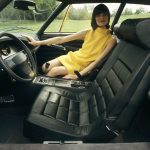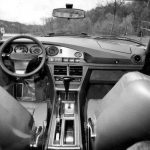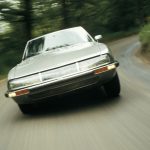
(english below)
Unsere deutsche Übersetzung der Pressemitteilung von DS Automobiles:
DS AUTOMOBILES FEIERT DAS JUBILÄUM DES SM AUF DER RETROMOBILE PARIS
Datum der Veröffentlichung : 30/01/2020
In Automobilkreisen ist der SM, der im Jahr 2020 sein fünfzigjähriges Jubiläum feiert, der Inbegriff für einen “majestätischen” Großraum-Tourenwagen. Der SM ist ein attraktives und harausragendes Beispiel für die Zusammenarbeit zwischen den französischen und italienischen Herstellern. Im Jahr 1970 erreichte er den Höhepunkt der Avantgarde und eroberte sich einen Platz in der Geschichte der Industrie und in den Herzen der Autoliebhaber. Auf der Retromobile 2020 feiern DS Automobiles und DS Heritage diese einzigartige Leistung, ein Symbol für die Verbindung von Verfeinerung und Technologie, mit drei SMs, die neben dem DS X E-TENSE stehen, dem Erben dieses gewagten Abenteuers.
Die Avantgarde von DS und SM als Teil von DS Automobiles
Die DS war bereits eine Legende, als das Projekt “S” in den 1960er Jahren gestartet wurde. Ziel war es, den technologischen Vorsprung und das Image der DS zu nutzen, um ein Sportfahrzeug zu produzieren, das die gleiche Strömung adressiert. Jacques Né, der für das Projekt verantwortliche Ingenieur, hatte zunächst die 24 Stunden von Le Mans im Visier, aber der Geschäftsführer Pierre Bercot richtete seine Forschung schnell auf ein Prestigefahrzeug aus, das über dem noch in Produktion befindlichen DS platziert werden sollte.
Die gemeinsame Nutzung von Komponenten war während der Entwicklung unerlässlich. Die neue Kreation sollte auf dem Fahrgestell eines DS basieren und auf denselben Montagelinien am Quai de Javel in Paris montiert werden.
Unter der Leitung von Robert Opron stellte ein Team unter Jean Giret und Jacques Charreton den Entwurf des späteren SM fertig. In den Werkstätten in der Rue du Théâtre wurde ein Modell im Maßstab 1:1 hergestellt. Die Ankunft von Maserati im Hause Citroën eröffnete neue Perspektiven, und ein italienischer Workshop startete eine Studie über einen kleinen, modernen V6…
Auf dem Genfer Autosalon 1970 wurde der SM als würdiger Erbe des DS vorgestellt. Der Grand Tourisme hatte viele Stärken: eine ebenso flüssige wie aggressive Linie, ein auf der berühmten hydraulischen Federung basierendes Fahrgestell, ein futuristisches Interieur mit ovalen Zifferblättern und einen Maserati V6-Motor. Die DNA des DS wurde vervielfältigt.
Unter der langen Motorhaube erhielt der 90°-V6 zwei obenliegende Nockenwellen pro Zylinderbank. Der Hubraum wurde absichtlich auf 2.670 ccm begrenzt, um unter der in Frankreich sehr belastenden Barriere von 16 Steuer-PS (16CV) zu bleiben. Der besonders kompakte (31 Zentimeter Länge) und sehr leichte (140 Kilogramm) Leichtmetallblock wird zunächst von drei Weber-Doppelvergasern für 170 PS bei 5.500 U/min gespeist, bevor er in späteren Baujahren die mit Bosch entwickelte elektronische Kraftstoffeinspritzung erhält, die die Leistung auf 178 PS erhöht und gleichzeitig die Einsatzflexibilität erhöht.
Der SM übernahm das zentrale Hydrauliksystem, das den DS zum Erfolg machte. Die grüne LHM-Flüssigkeit speiste und unterstützte einige der Hauptfunktionen: Federung, Bremsen (gesteuert durch ein pilzförmiges Pedal), Lenkung und vertikale Einstellung der Scheinwerfer. Besondere Aufmerksamkeit wurde der Weiterentwicklung des Frontantriebs gewidmet, um dem SM die schnellste Traktion der Welt zu verleihen, mit einem bemerkenswerten Unterschied im Vergleich zum DS – einer Spurstangen-Vorderachse.
Innovation als Motor
Die Steuerung war nur eine der großen Neuerungen der SM. Sie hieß DIRAVI, für “DIrection à RAppel asserVI” und hatte die Besonderheit, dass sie dank eines am Ende des Getriebes montierten hydraulischen Reglers mit höherer Geschwindigkeit umso straffer wird. Diese Lenkung war dagegen besonders leicht und direkt in der Stadt und stabiler bei hohen Geschwindigkeiten.
Der automatischen Scheinwerferkorrektur wurde eine neue Dimension hinzugefügt. Wie der DS profitierte auch der SM von zwei rotierenden externen Langstrecken-Scheinwerfern. Aber auch die sechs Halogenscheinwerfer, die Cibié hinter der Saint-Gobain-Glasabdeckung entworfen hat, erhielten Regelungen, die sich automatisch in der Höhe an die jeweilige Fahrzeugposition anpassen.
Die Prägung und Montage der Karosserien erfolgte in der Fabrik von Chausson de Gennevilliers. Anschließend wurde alles per Lastwagen zum Quai de Javel transportiert, um dort auf denselben Montagelinien wie die DS endmontiert zu werden.
Fünfzig Jahre später ist der SM eine Ikone. Komfort und Straßenlage machen ihn zu einem sehr modernen Auto. Herausragend sind seine Linienführung, sowohl innen als auch außen, kombiniert mit seinem Pilzpedal, dem innovativen Hydrauliksystem und der variablen Lenkunterstützung an der Spitze. Und obwohl das die übliche Wahrnehmung für das Einstellen des Verkaufs dem plötzlichen Anstieg der Benzinpreise im Zuge der Ölkrise zuschreibt, bleibt der SM einer der effizientesten GTs seiner Zeit.
DS Automobiles entstand aus dem gleichen Wunsch heraus, Avantgarde, Verfeinerung und fortschrittliche Technologien in seine zeitgenössischen Kreationen einzubringen.
Georges Pompidou, Präsident der französischen Republik zum Zeitpunkt der Markteinführung des SM, und auch Leonid Breschnew, der Schah von Iran, Haïlé Sélassié, Burt Reynolds, John Williams, Johan Cruyff, Bernard Pivot, Line Renaud oder Jay Leno hatten oder haben einen SM gefahrren. Und Daniel Craig gibt zu, dass es immer das Auto seiner Träume war…
Das jährliches Treffen für Liebhaber historischer Automobile, die Rétromobile, wird auch dieses Jahr wieder auf 72.000 m² auf der Pariser Expo, Porte de Versailles, stattfinden. Die Ausstellung ist von Mittwoch, dem 5. Februar, bis Sonntag, dem 9. Februar, von 10 bis 19 Uhr (Mittwoch- und Freitagabend bis 22 Uhr) für das Publikum geöffnet.
Wussten Sie?
* Jacques Nés erstes “S”-Projekt bestand darin, ein Fahrzeug zu entwickeln, das für das 24-Stunden-Rennen von Le Mans eingesetzt werden kann.
* Der SM war das erste neue Modell aus der Ära Robert Opron – nach dem Tod seines Vorgängers Flaminio Bertoni – und gleichzeitig die letzte Kreation, die in der Rue du Théâtre in Paris entworfen wurde, bevor die Designabteilung nach Vélizy umzog.
* Zum Zeitpunkt der Vermarktung im Juni 1970 betrug der Preis für den SM 46.000FF. Der SM Injection wurde im April 1975 für 84.000FF verkauft.
* Die Farbe “Brun-Scarabée” (Käferbraun) war der meistverkaufte Farbton. “Feuille dorée” (Blattgold) und “Sable métallisé” (Sand-Metallic) markierten ebenfalls den Beginn der Karriere des SM.
* Zwischen 1970 und 1975 wurden im Werk am Quai de Javel in Paris 12.920 Autos produziert.
* Der Karosserier Henri Chapron baute sieben Sondermodelle des Typs “Mylord” (Cabriolet), zwei Fahrzeuge des Typs “Elysée” (Cabriolet für offizielle Zeremonien) sowie sieben “Opera” (viertürig). der Karosserier Heuliez entwarf zwei “SM Espace”.
DS Automobiles auf der Rétromobile 2020
Drei SM und ein DS Cabriolet werden auf der Rétromobile 2020 ausgestellt, mit dem DS X E-TENSE, unsere Vision für das Jahr 2035.
* Ein 1971er SM Vergaser
* Ein 1972 SM Injection
* Ein 1971 SM Espace, Karosserie von Heuliez
* Ein DS Cabriolet, vor 60 Jahren vorgestellt
Und DS X E-TENSE
Ein Auto, das “leicht wie eine Feder” und “leise wie eine Brise” ist, geschmiedet von der Vision seiner Schöpfer, für Menschen, die sich für Autos begeistern: Die Vorstellung eines Traumautos für das Jahr 2035 veranlasste DS Automobiles, ein asymmetrisches Dreisitzkonzept zu entwickeln, das auf einer einzigartigen Verbindung von zwei Fahrzeugen in einem Fahrzeug basiert und es dem Besitzer ermöglicht, den Fahrmodus zu wählen, der seinen Bedürfnissen in jedem Moment entspricht.
Dank einer neuen Technologie ist die Fahrzeugkarosserie in der Lage, nach einem Aufprall ihre ursprüngliche Form wieder zu erlangen, während sich die Konfiguration des Frontgitters und die Kühlleistung des DS X E-TENSE den Impulsen des Fahrers anpassen. Dank der Lichtvorhänge DS LIGHT VEIL wird die Helligkeit der Leuchten durch eine Funktion gesteuert, die sich an die Bedürfnisse der Insassen, des Fahrzeugs und seiner Umgebung anpasst.
Die beiden Motoren, die als Stromquelle für den vollelektrischen DS X E-TENSE gewählt wurden, befinden sich in den Vorderrädern und bieten eine unvergleichliche Reaktion. Für den Straßenbetrieb liegt die Spitzenleistung bei 400kW (540 PS), eine Zahl, die im “Circuit”-Modus auf 1.000kW (1.360 PS) ansteigt und es dem Fahrer ermöglicht, die exquisite Leistung der von DS Performance, dem technischen Team hinter dem Formel-E-Programm von DS, entwickelten Aufhängung zu genießen. Das Karbonfaser-Fahrgestell sitzt auf innovativen Federn und Drehstäben, während Traktion, Grip und Verzögerung durch ein fortschrittliches aktives System gesteuert werden, das zur Optimierung der Leistung unabhängig von der Art der Straßenoberfläche konzipiert wurde.
Der Zugang zum Cockpit erfolgt über eine Elytre-Tür, die mit einem Karbonfaser-Leder-Gewebe verkleidet ist. Der Blick wird unweigerlich auf die pyramidenförmige Architektur des Einzelsitzes gelenkt, der sich perfekt an den Körperbau des Fahrers anpasst, wie die im Rennsport üblichen Sitze. Das Lenkrad hingegen, das dem Symbol entspricht, das es seit jeher gegenüber der Leidenschaft für Autos darstellt, ist eine verlockende Kombination aus Leder, Holz und Metall. Das zweifarbige Leder Millennium Blue und Navy Blue Aniline ist mit dem DS-Markenzeichen, dem Perlsteppmuster, veredelt. Allein diese Ausstattung trägt zu dem Versprechen eines einzigartigen Erlebnisses bei, wenn sie einmal im Cockpit installiert ist, und gibt dem Fahrer einen Adrenalinschub, noch bevor er sich zurückziehen kann.
Wenn man über die Flügeltür in den Kokonteil des Innenraums steigt, wird der Fahrer, allein oder in Begleitung, zum Beifahrer. Diese asymmetrische Anordnung gibt unter dem klaren Glasdach einen anderen Raumtypus frei, in dem der Passagier in einer sinnlichen Kapsel eingeschlossen ist und sich in einem belüfteten und mit Massagefunktion ausgerüsteten Sitz befindet, der sich wie ein ausgefahrener Vogelflügel nach hinten streckt, wobei ein “Federstern-Motiv” den oberen Teil des Rückens krönt. Das Reisen mit aktiviertem autonomen Modus ist eine außergewöhnliche Erfahrung, da andere Sinne als der Tastsinn ins Spiel kommen. Der Innenraum ist akustisch darauf ausgelegt, einen aussergewöhnlichen Hörgenuss zu erleben, unter dem Label FOCAL. Das Armaturenbrett erfindet sich neu zu einem Generator des musikalischen Flusses: in Echtzeit angepasste Klangstrahlen folgen dem Zuhörer, indem sie sich an jede seiner Bewegungen anpassen.
—–
The press release of DS Automobiles for Retromobile 2020:
DS AUTOMOBILES CELEBRATES THE SM’S JUBILEE AT RETROMOBILE
Date of publication : 30/01/2020
In automotive circles, the epitome of majestic grand touring cars is the SM, celebrating its fiftieth anniversary in 2020. Attractive and magnificent, the SM was a major example of collaboration between iconic French and Italian manufacturers. In 1970, it took the avant-garde to its peak and carved out a place for itself in the history of the industry and in the hearts of car lovers. At the 2020 Retromobile Show, DS Automobiles and DS Heritage are celebrating this unique achievement, a symbol of combining refinement and technology, with three SMs standing alongside the DS X E-TENSE, heir to this daring adventure.
The avant-gardism of the DS and SM behind DS Automobiles
The DS was already a legend when Project “S” was launched in the 1960s. The aim was to take advantage of the DS’s technological lead and image to produce a sports vehicle that would be in the same vein. Jacques Né, the engineer in charge of the project, initially had the 24 Hours of Le Mans in his sights, but Managing Director Pierre Bercot quickly redirected his research towards a prestige car, one to be placed above the DS which was still in production.
Sharing components was essential during development. The new creation was to be based on the chassis of a DS and assembled on the same assembly lines at the Quai de Javel, in Paris.
Under the direction of Robert Opron, a team led by Jean Giret and Jacques Charreton finalised the design of what would become the SM. A 1:1 scale model was produced in the Rue du Théâtre workshops. The arrival of Maserati in Citroën’s fold opened up new prospects and an Italian workshop launched a study into a small, modern V6…
Introduced at the 1970 Geneva Motor Show, the SM emerged as the worthy heir to the DS. The Grand Tourisme had many strengths: a line that was as fluid as it was aggressive, a chassis based on the famous hydraulic suspension, a futuristic interior with egg-shaped dials and a Maserati V6 engine. The DS’s DNA was amplified.
Under the long bonnet, the 90° V6 acquired two overhead camshafts per cylinder bank. The cylinder capacity was deliberately limited to 2,670 cc to remain under the very penalising barrier in France of 16 fiscal horsepower. Particularly compact (31 centimetres in length) and very light (140 kilograms), the alloy block is initially fed by three dual-body Weber carburettors for 170 horsepower at 5,500 rpm before receiving electronic fuel injection developed with Bosch to increase the power to 178 horsepower while gaining flexibility of use.
The SM took over the central hydraulic system that made the DS a success. Green LHM fluid fed and supported some of the main functions: suspension, braking (controlled by a mushroom-shaped pedal), steering and vertical adjustment of the headlights. Special attention was paid to studying the suspension to give the SM the fastest traction in the world with a notable difference compared to the DS – a tie-rod front axle.
Innovation as engine
Steering was just one of the SM’s great innovations. Called DIRAVI, for DIrection à RAppel asserVI (memory power-assisted steering), it had the special feature that it hardens with speed, thanks to a hydraulic governor mounted at the end of the gearbox. This steering was particularly light and direct in town and more stable at high speeds.
A new dimension was added to automatic headlight correction. Like the DS, the SM benefited from two rotating external long-range headlights. But the six halogen headlights, designed by Cibié behind their Saint-Gobain shop front, also acquired plates that automatically adjusted height according to the car’s attitude.
The stamping and fitting of the bodies was performed in the Chausson de Gennevilliers factory. Everything was then transported by lorry to the Quai de Javel for final assembly on the same assembly lines as the DS.
Fifty years on, and the SM is a symbol. Comfort and road handling make it a very modern car. Its lines, both inside and out, remain at the forefront with its mushroom pedal, the whispering hydraulic system and variable assisted steering. And although popular thinking credits the end of its marketing to the sudden increase in petrol prices with the oil crisis, the SM remains one of the most efficient GTs of the era. DS Automobiles was born out of the same desire to bring avant-gardism, refinement and advanced technologies to its contemporary creations.
Georges Pompidou, President of the French Republic at the time of its launch, but also Leonid Brezhnev, the Shah of Iran, Haïlé Sélassié, Burt Reynolds, John Williams, Johan Cruyff, Bernard Pivot, Line Renaud or Jay Leno had or still have one in the form of an SM. And Daniel Craig admits that it’s always been the car of his dreams…
An annual meet-up for car enthusiasts, Rétromobile, will once again this year spread over 72,000 m² at Paris Expo, Porte de Versailles. The Show will be open to the public from Wednesday 5 February to Sunday 9 February from 10 a.m. to 7 p.m. (Wednesday and Friday evenings until 10 p.m.).
Did you know?
* Jacques Né’s first “S” project was to devise a vehicle that could be entered in the 24-Hour Le Mans race.
* The first new model from the Robert Opron era after the death of Flaminio Bertoni, the SM was also the last creation designed at the Rue du Théâtre in Paris, before the style department moved to Vélizy.
* At the time of marketing in June 1970, the price for the SM was FF 46,000 (46,400 constant euros). The SM Injection was sold for 84,000 FF in April 1975 (54,000 constant euros).
* The colour Brun scarabée (Beetle Brown) was the best-selling shade. Feuille dorée (Gold Leaf) and Sable métallisé (Metallic Sand) also marked the beginning of the SM’s career.
* 12,920 cars were produced at the Quai de Javel plant in Paris between 1970 and 1975.
* Henri Chapron Bodywork built seven Mylords (convertible), two Elysées (convertible for official ceremonies) and seven Operas (four-door). Heuliez designed two SM Espace.
DS Automobiles at Rétromobile 2020
Three SM and a DS Cabriolet will be exhibited at Rétromobile 2020, with DS X E-TENSE, our dream car for 2035.
A 1971 SM Carburateur
A 1972 SM Injection
A 1971 SM Espace, by Heuliez
A DS Cabriolet, launched 60 years ago
And DS X E-TENSE
A car that’s as ‘light as a feather’ and as ‘silent as a breeze’, forged by its creators’ vision, for people who are passionate about cars. Imagining a dream car for 2035 led DS Automobiles to create an asymmetric, three-seat concept founded on a unique association of two vehicles in one that allows owners to select the driving mode that matches their need at any given moment.
Due to new technology, the vehicle body is capable of recovering its original form after an impact, while the configuration of the front grille and DS X E-TENSE’s cooling capacity adapt to the driver’s impulses. Owing to DS LIGHT VEIL light curtains, the lights brightness is controlled by a function to adjust based the requirements of the occupants, the car and its surroundings.
Located within the front wheels, the two motors selected as the source of the all-electric DS X E-TENSE’s power provide unrivalled response. For road use, peak power stands at 400kW (540 horsepower), a figure that rises to 1,000kW (1,360 horsepower) in ‘circuit’ mode which allows the driver to savour the exquisite performance of the suspension engineered by DS Performance, the technical team behind DS’s Formula E programme. The carbon fibre chassis sits on innovative springs and torsion bars, while traction, grip and deceleration is controlled by an advanced active system conceived to optimise performance, whatever the type of road surface.
The cockpit is accessed by an Elytre door that is trimmed with a carbon fibre/leather weave. Inevitably, the eyes are drawn to the pyramidal architecture of the single seat, which adapts perfectly to the driver’s build like the fitted seats seen in motor racing. The steering wheel, meanwhile, in keeping with the symbol it has always represented vis-à-vis the passion for automobiles, is an enticing combination of leather, wood and metal. The two-tone Millennium Blue and Navy Blue Aniline leather is finished with DS’s trademark pearl topstitch pattern. These appointments alone contribute to the promise of a unique experience once installed inside the cockpit and provide the driver with an adrenalin rush even before they pull away.
Climb into the cocoon part of the interior via the gullwing door and the driver, alone or accompanied, becomes a passenger. This asymmetric layout frees up a different type of space underneath the clear glass canopy, with the passenger enclosed in a sensuous capsule, snug in a ventilated, massaging seat that stretches back like a deployed bird’s wing, with a feather star motif crowning the top of the back. Travelling with the autonomous mode engaged is an exceptional experience as other senses than touch come into play. The interior space is an immersive acoustic bubble dedicated to the pleasure of listening, signed FOCAL. The dashboard reinvents itself into a generator of musical flow: sound beams adjusted in real time follow the listener by adapting to each of his movements.


